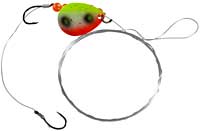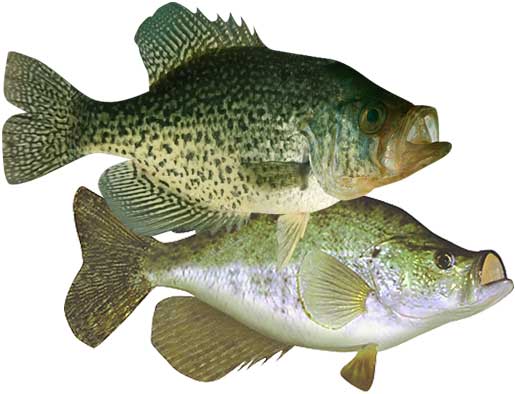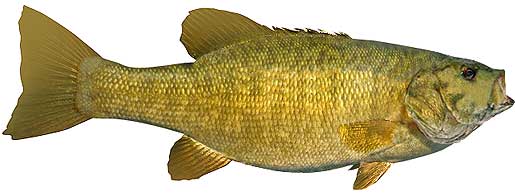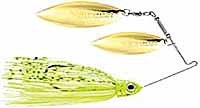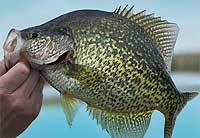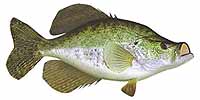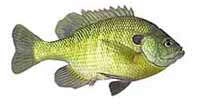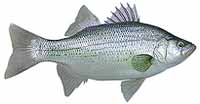Fishing Report For Ute Lake, NM
By Rick Seaman
August 25, 2025

Fishing Reports
Popular Fish Species Ute Lake, NM
Walleye
Current Report: Good To Very Good
Ute Lake was home to previous state record walleye, and is considered one of the better walleye fisheries in the Southwest.
SUMMER. Currently the water temperature is in the high 70's, and walleye fishing has been quite good. Throughout Summer, early in the morning, and from dusk to long after dark have been good times to catch walleye. At those times they move shallower to feed, especially in low-light conditions. The rest of the time they are suspending on long points, or cruising flats and creek channel edges, in 12 to 20 feet of water. Trolling crankbaits or worm harnesses has been catching nice walleye. Bottom bouncing jigs tipped with minnows, grubs and nightcrawlers, fished just off the bottom is also catching walleye.
FALL. Fall brings cooler temperatures to shallow water, drawing walleye and baitfish into the shallows. Jigs, swimbaits, spoons, crankbaits, jerkbaits, and spinnerbaits are all historically good for catching walleye again. Most walleye are hanging in 10 to 20 feet of water. Watch for the bigger walleye to be slightly deeper than the majority of the school.
WINTER. This Winter fishing for walleye was decent. They primarily feed on gizzard shad and other small fish, staying close to the bottom. Blade baits, jigs, swimbaits, spoons, deep-diving crankbaits, and worm harness spinners, are all working while trolling or drifting. Slow presentations are in order.
SPRING. Anglers will begin moving to the upper end of the lake, where anglers are finding walleye in the shallows, especially rocky areas and inlet channels. Windy points and flats draw baitfish, and walleye follow. Here they will spawn once the water warms to the mid to high 40's. Afterwards, they move to shallow points, flats, shoals and ledges, just off shore and relatively close to their spawning areas. Bright colored jigs, tipped with minnows or nightcrawlers typically catch them in 5 to 15 feet of water. Spinnerbaits, jerkbaits and crankbaits are also working when walleye are up shallow.
Black Crappie & White Crappie
Current Report: Fair To Good
SUMMER. Water temperatures are currently in the high 70's, and crappie fishing has been slow. Now that the hot Summer sun has warmed the shallows, crappie retreated to depths of 12 to 20 feet. Anglers are locating schools of crappie hanging over deep rocky structures and around creek channel edges.
FALL. Baitfish, which will be moving into shallow flats, coves and bays, will draw crappie into these areas, where they will feed heavily in preparation for the cold Winter. Small spoons, along with minnows, hair jigs, and crappie jigs, are good options during this feeding marathon. Late fall starts the migration deeper toward winter holding areas, for both crappie and baitfish. Flutter spoons are ideal during this transition
WINTER. Once the shallows start cooling rapidly, crappie will migrate to deeper holding areas, mostly off shore.By early December they are typically caught using a very slow presentation, along ledges, in 20 to 35 feet of water. If they are suspending in open water, they often relate to some cover, or structure change, directly below them.
SPRING. In early Spring, crappie begin staging in 15 to 20 feet of water, just outside shallow spawning bays and flats. Spring is the ideal time to be on the water, as crappie are moving shallow to spawn. During the spawn, they are typically caught in 2 to 8 feet of water. Brush, wood and vegetation are where most anglers are catching slabs using small crappie jigs or live minnows. After the spawn, crappie move outside the spawning area and typically hold deeper, on close by cover. Once they move off the beds, anglers are reporting good success using fish finders and forward facing sonar to locate schools of crappie, which tend to stack vertically around cover. Light tackle with 4 lb to 8 lb line is a popular choice.
Smallmouth Bass
Current Report: Good To Very Good
Ute Lake is considered one of the top smallmouth lakes in the state.
SUMMER. Smallmouth bass are currently feeding shallow early and late in the day, where they are being caught on topwater, crankbaits, swimbaits, Ned rigs and tube baits. Smallmouth bass here feed on crawfish, gizzard shad, and small sunfish. They prefer rocky or gravel bottom areas, as this is where crayfish live. During the hotter parts of the day, they are being caught on points, humps, and ledges 10 to 20 feet deep. Often these deeper fish are part of a sizeable school of smallmouth. Anglers fishing in the Canadian River arm, are reporting good catches.
FALL. As Fall arrives, smallmouth here follow schools of baitfish into coves and bays, where spoons, drop-shots, and slow-rolled spinnerbaits, are very successful. The average fish being caught averages about 2 1/2 pounds, but plenty of 3 to 5 pound smallies are being caught as well. Early in Fall the smallies are shallow, then migrate to deeper water as Fall lingers, often to 50 feet deep or more. Fishing shallow for smallmouth is often good on cold, windy, cloudy and rainy days.
WINTER. Winter will isolate them around deeper structure, points and creek channels, often suspending in open water above these features. They can generally be found from 40 to 60 feet deep. Here they hold, feeding less frequently, awaiting warmer water to return in Spring.
SPRING. When water temperatures rise into the 50's now, smallmouth have moved from deep wintering spots to shallower water, just outside spawning areas. They feed heavily at this time, and are typically caught on jerkbaits, spinnerbaits, crankbaits, tube baits, Ned rigs, and crayfish imitating plastics, in 5 to 15 feet of water. Once water warms into the high 50's, they concentrate in slightly shallower water, and create nests in gravel or sand, then lay their eggs. Females then move to deeper water and males remain to guard the eggs, and then the fry. After a couple weeks, the males also move to slightly deeper water and feed aggressively. Crankbaits, tube baits, Ned rigs, plastic worms, spoons and swimbaits are catching smallies during this period.
Fishing Video
Fish species to fish for...
Guide to fishing for largemouth bass, smallmouth bass, channel catfish, black crappie, white crappie, walleye, bluegill and white bass at Ute Lake in New Mexico.
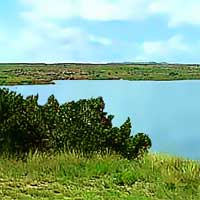
Ute Lake is an 8,200-acre lake with 45 miles of shoreline. The lake has healthy populations of bass, walleye, both black and white crappie, white bass, catfish and sunfish. There is limited access for fishing from the bank.
Primary fish species to catch
Click images for fishing tips and details about each species.
Today's Weather & Forecast
Public Boat Launch Ramps & Landings
Click here for boat ramps.
Marinas
Click here for marinas.
Fishing License
Click here for a New Mexico Fishing License.
Map - Fishing & Access
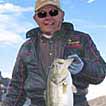
Rick Seaman is a fishing enthusiast with over five decades of fishing experience, a retired tournament fisherman, author of numerous published articles on fishing, and co-author of the book "Bass Fishing - It's not WHAT you throw, It's WHERE you throw it".
Contact Information
Ute Lake State Park
1800 Loop 540
Logan, NM 88426
575 487-2284
Fishing lakes in each state
082525





